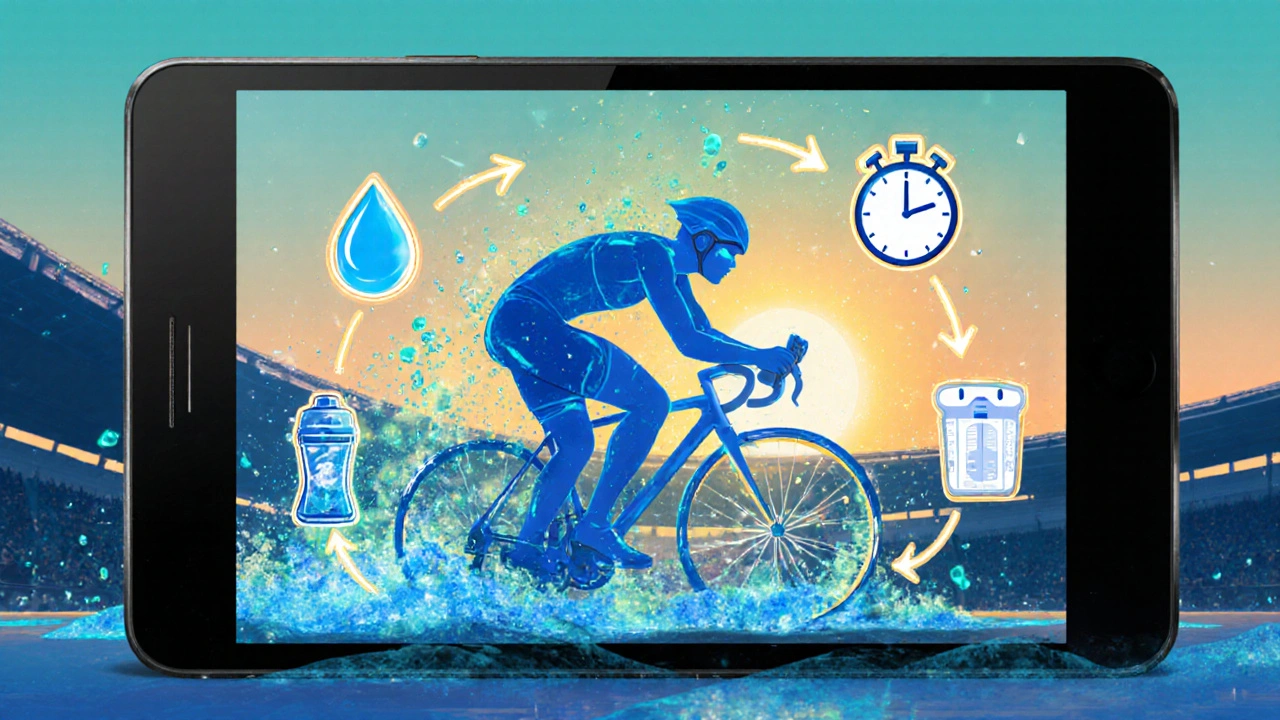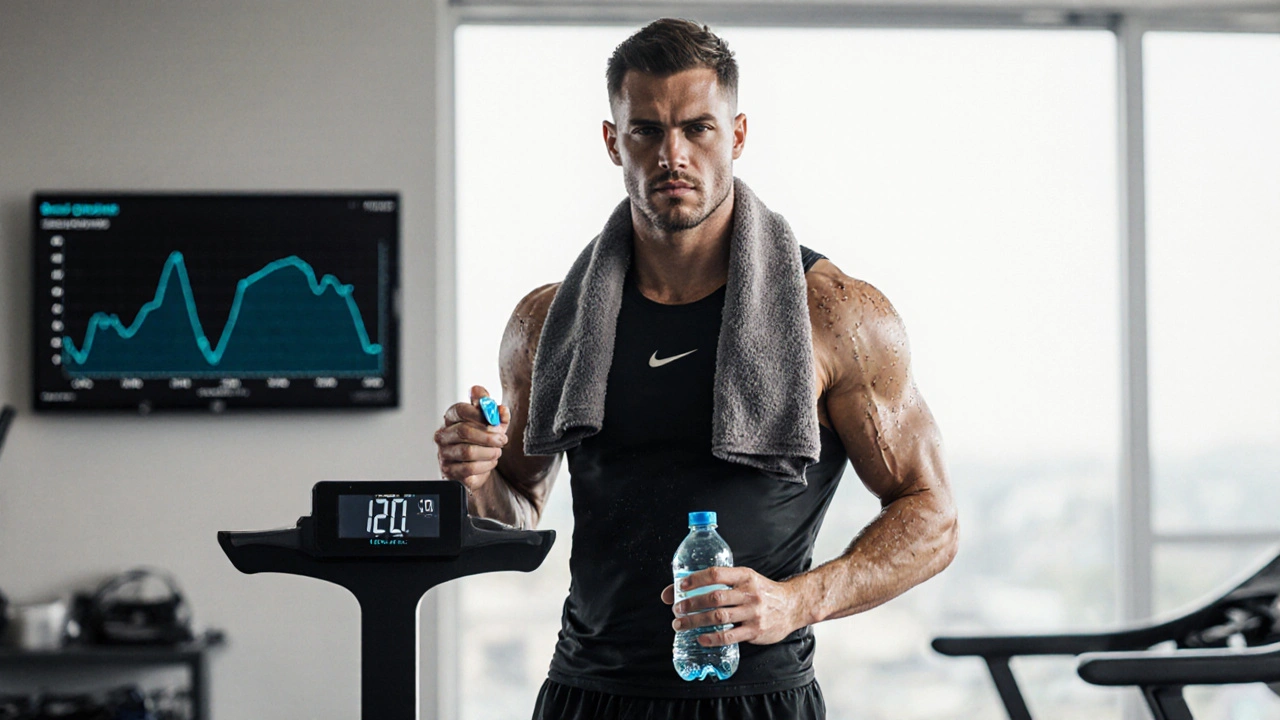Athlete Hydration Calculator
This tool helps calculate your sweat rate and estimated sodium loss to help prevent hyponatremia during endurance activities.
Enter Your Details
Quick Summary
- Know what hyponatremia is and why it hits endurance athletes hard.
- Track sweat rate and adjust fluid intake, not the other way around.
- Include sodium‑rich drinks or foods every 45‑60 minutes of activity.
- Use urine color, body weight, and simple field tests to spot early trouble.
- Avoid the ‘drink as much as possible’ myth - balance water with electrolytes.
What is Hyponatremia?
When the blood’s sodium concentration drops below 135mmol/L, the condition is called Hyponatremia a low‑sodium electrolyte disorder that can cause brain swelling, nausea, and in severe cases, seizures or death. It’s not just a medical curiosity; for athletes pushing limits, it can turn a personal best into a medical emergency.
Why Athletes Are Prone
Endurance runners, cyclists, triathletes, and even team‑sport players can develop low sodium for three main reasons:
- Athletes people engaged in prolonged, high‑intensity physical activity lose large amounts of sodium through sweat.
- Many follow the “drink as much as you can” mantra, diluting blood sodium.
- Some training plans don’t include sodium‑rich foods or drinks during long sessions.
Understanding the balance between Sodium an essential electrolyte that regulates fluid balance and nerve function and water is the first step to prevention.
Spotting the Early Signs
Symptoms can creep in slowly, making them easy to miss. Look for:
- Unexplained nausea or vomiting
- Headache that doesn’t improve with rest
- Dizziness or a “foggy” feeling
- Muscle cramps that feel different from normal fatigue
- Rapid weight gain (more than 2% of body weight) during a training session
If any of these appear, pause, sip a sodium‑containing drink, and reassess. Severe cases may involve confusion, seizures, or loss of consciousness - call emergency services immediately.
Building a Hydration Plan That Works
One‑size‑fits‑all won’t cut it. Follow these steps to create a custom plan:
- Measure your sweat rate. Weigh yourself nude before and after a one‑hour run, then add any fluid consumed. Each kilogram lost equals about one liter of sweat.
- Calculate sodium loss. On average, sweat contains 450-700mg of sodium per liter. Multiply your sweat volume by the midpoint (≈575mg/L) for a rough estimate.
- Set fluid targets. Aim to replace 75‑80% of fluid lost during the activity, not 100%.
- Example: Lose 1.5L → drink 1.2L over the session, spread evenly.
- Add sodium every 45‑60minutes. A 500ml sports drink with ~200mg Na⁺ works for most people; adjust upward if you sweat heavily or train in heat.
- Practice during training, not on race day. This lets you fine‑tune taste, stomach comfort, and logistics.

Sodium Sources & Strategies
Besides commercial sports drinks, there are several practical ways to keep sodium levels healthy:
- Electrolyte tablets: dissolve a tablet in water for a portable, low‑calorie boost (≈300mg Na⁺ per tablet).
- Salty snacks: pretzels, nuts with sea salt, or a small bag of olives.
- Broth‑based drinks: low‑fat chicken broth offers 600‑800mg Na⁺ per cup and adds warmth on cold‑weather runs.
- DIY sports drink: mix 1L of water, ½tsp of table salt, a squeeze of orange juice, and a teaspoon of honey for flavor and ~250mg Na⁺.
Remember, the goal isn’t to “load up” on salt but to replace what you lose.
Monitoring & Testing on the Go
Real‑time feedback lets you adjust before a problem develops:
- Urine color: light straw indicates good hydration; dark amber suggests over‑dehydration or inadequate fluid intake.
- Body weight checkpoints: weigh in before, during (if possible), and after long workouts. A jump of >2% signals excess fluid.
- Portable blood sodium test kits (e.g., i-STAT): used by elite teams to get a serum sodium reading within minutes.
- ADH antidiuretic hormone that tells kidneys to retain water, often elevated during prolonged endurance events levels can spike, making you retain water even when you’re not thirsty. Understanding this helps you avoid forced over‑hydration.
Even simple tools like a pocket scale and a notebook can provide enough data to keep you safe.
Common Mistakes to Avoid
Here are pitfalls that turn good intentions into danger:
- Drinking exclusively plain water for hours on end.
- Skipping sodium because you “don’t like salty taste.” A pinch of salt in a smoothie works just as well.
- Relying solely on thirst - the body’s thirst mechanism lags behind fluid loss.
- Using low‑sodium “light” sports drinks during hot, humid training.
- Neglecting post‑exercise rehydration. Replace fluids and sodium within 30minutes of finishing.
Hydration Strategy Comparison
| Attribute | Plain Water | Sports Drink (e.g., Gatorade®) | Electrolyte Tablet + Water |
|---|---|---|---|
| Sodium (mg/L) | 0-5 | 200‑250 | 300‑350 (tablet dissolved in 500ml) |
| Carbohydrate (g/L) | 0 | 6‑8 | 0‑2 (optional glucose) |
| Best for | Short (<60min) low‑intensity sessions | Endurance events 1‑3h in warm climates | Long (>3h) ultra‑endurance or when you need precise sodium control |
| Pros | Readily available, no calories | Convenient, balanced electrolyte mix | Customizable, lower sugar, high sodium |
| Cons | Risk of hyponatremia if over‑consumed | May contain excess sugar for some athletes | Requires preparation, taste can be bland |
Putting It All Together: A Sample Race Day Plan
Imagine you’re gearing up for a 35km trail run in 30°C weather. Here’s a practical checklist:
- Night before: Eat a balanced dinner with moderate salt (e.g., grilled salmon, quinoa, roasted veggies). Hydrate with water + a pinch of sea salt.
- Morning: Weigh yourself; note the number. Drink 500ml of a sodium‑enhanced beverage (≈200mg Na⁺) 30minutes before start.
- During race: Carry two 500‑ml bottles - one plain water, one sports drink. Sip alternately every 10minutes, aiming for 150ml per sip.
- Every 45minutes: Pop an electrolyte tablet dissolved in 250ml water for a quick sodium top‑up.
- Mid‑point (≈15km): Check urine color; if darker than straw, add an extra 250ml of sports drink.
- Finish: Weigh again. If you’ve gained >1% of body weight, you’ve likely over‑hydrated - note and adjust next time.
This routine blends fluid volume, sodium intake, and real‑time monitoring to keep hyponatremia at bay.
Frequently Asked Questions
What is the safe range of serum sodium for athletes?
Normal serum sodium sits between 135mmol/L and 145mmol/L. Values below 135mmol/L indicate hyponatremia, and athletes should aim to stay above this threshold during and after prolonged activity.
Can I rely on sports drinks alone?
Sports drinks usually supply enough sodium for moderate‑duration events (1‑2hours). For ultra‑endurance races or exceptionally salty sweat, supplement with tablets or salty foods to hit higher sodium targets.
How quickly can hyponatremia develop?
It can develop within a few hours if you drink large volumes of low‑sodium fluid while sweating heavily. Early symptoms often appear after 2‑3hours of continuous exercise in warm conditions.
Is thirst a reliable guide?
No. Thirst lags behind fluid loss and can be suppressed by high‑intensity exercise. Use weight checks, urine color, and a pre‑planned fluid schedule instead.
Should I weigh myself before every workout?
For training sessions longer than 60minutes, weighing before and after helps you gauge sweat loss and informs how much fluid you need to replace.







September 30, 2025 AT 21:02
Quick tip: aim for about 75‑80% of your sweat loss in fluids and add a pinch of salt to your bottle – it’s cheap and works.